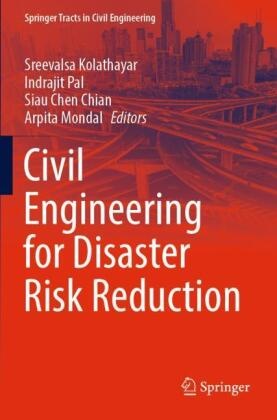Civil Engineering for Disaster Risk Reduction
| Verlag | Springer |
| Auflage | 2022 |
| Seiten | 489 |
| Format | 15,5 x 2,7 x 23,5 cm |
| Gewicht | 759 g |
| Artikeltyp | Englisches Buch |
| Reihe | Springer Tracts in Civil Engineering |
| EAN | 9789811653148 |
| Bestell-Nr | 81165314DA |
The book is a comprehensive volume on multi-hazards and their management for a sustainable built environment. It focuses on the role of civil engineering in building disaster resilient society. This book brings together all diverse disciplines of civil engineering and related areas (for example, geotechnical engineering, water resources engineering, structural engineering, transportation engineering, environmental engineering, construction management, GIS, and remote sensing) towards a common goal of disaster resilience through an interdisciplinary approach. It contains methods and case studies focusing on civil engineering solutions to reduce the disaster risk. The book contents are aligned in line with the priorities set by UN-Sendai Framework for Disaster Risk Reduction and UN-SDGs to promote a global culture of risk-awareness and disaster reduction. The book will be a useful comprehensive reference for disaster risk reduction beneficial for engineering students, teaching facul ty, researchers, industry professionals and policymakers.
Inhaltsverzeichnis:
Chapter 1: Introduction - Civil Engineering and DRR Connect.- Chapter 2: Disaster Risk Reduction and Sustainable Development.- Chapter 3: Prof. Dilanthi Amaratunga, Head, Global Disaster Resilience Centre.- Chapter 3: Geotechnical, Geological and Geophysical Investigations for Seismic Microzonation and Site-Specific Earthquake Hazard Analysis.- Chapter 4: Seismic Hazard Assessment - State of the Art and Future Directions.- Chapter 5: Earthquake Damage Scenario Analysis for Chennai City - A Geospatial Approach.- Chapter 6: Estimation of Local Site Effects: Lessons from Past Earthquakes, Current Practices and Future Trends.- Chapter 7: Post-Earthquake Reconnaissance: Theories and Observations.- Chapter 8: Coastal Disasters and Mitigation Measures.- Chapter 9: Tsunami Hazards.- Chapter 10: Multi-Hazard Monitoring and Forecasting: Hurricanes to Tsunamis.

